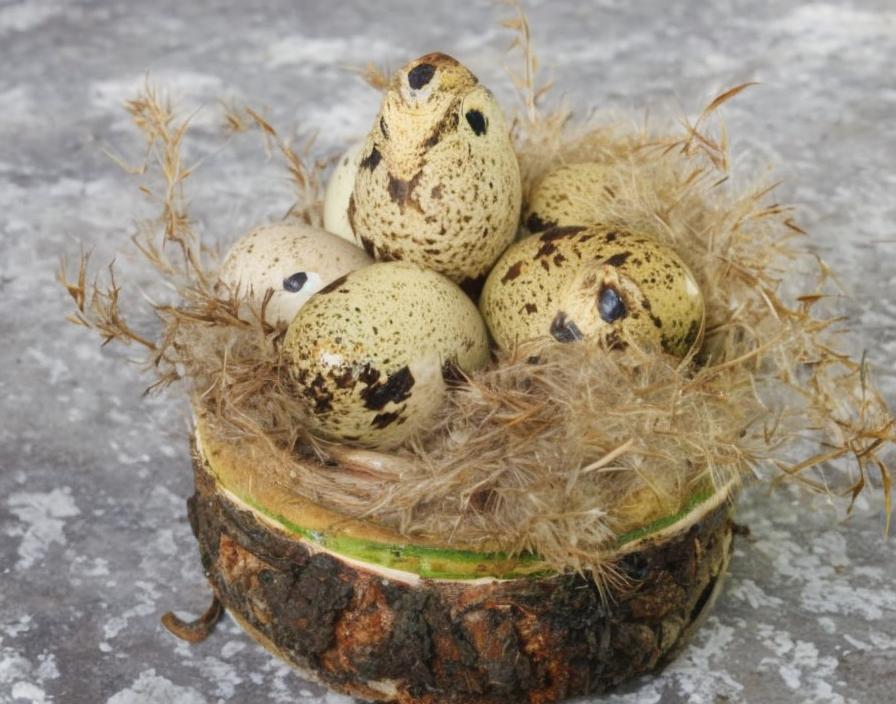Quail are small game birds that are known for their delicious eggs and meat. When it comes to egg production, there are several quail breeds that are popular among farmers and homesteaders. Understanding the different quail breeds and their characteristics is essential for anyone looking to start a quail egg production operation.
Quail breeds can be categorized into two main groups: Coturnix quail and Bobwhite quail. Coturnix quail, also known as Japanese quail, are the most popular breed for egg production due to their high egg-laying capacity and relatively docile nature. They come in various color variations, including Pharaoh, Tuxedo, Italian, and Golden Manchurian. On the other hand, Bobwhite quail are more commonly raised for meat production, but they also lay eggs, albeit in smaller quantities compared to Coturnix quail. Understanding the differences between these two main groups of quail breeds is crucial for selecting the right breed for egg production.
Quail breeds also vary in terms of their egg-laying capacity, size, and temperament. Some breeds are known for their prolific egg-laying abilities, while others may be more skittish and difficult to handle. Additionally, certain breeds may be better suited for specific climates or environments. Understanding these differences will help farmers and homesteaders make informed decisions when choosing quail breeds for egg production.
Key Takeaways
- Quail breeds for egg production vary in size, color, and egg-laying capabilities
- Popular quail breeds for egg production include Coturnix, Bobwhite, and Pharaoh
- Factors to consider when choosing quail breeds include climate, space, and desired egg production
- Best practices for raising quail breeds include providing proper housing, nutrition, and healthcare
- Tips for maximizing egg production from quail breeds include providing a balanced diet, proper lighting, and stress reduction techniques
- Common challenges in raising quail breeds for egg production include predator attacks, disease, and low egg production
- Conclusion: Choosing the right quail breed for egg production requires careful consideration of various factors to ensure successful egg production.
Popular Quail Breeds for Egg Production
1. Coturnix Quail: Coturnix quail, also known as Japanese quail, are the most popular breed for egg production. They are known for their high egg-laying capacity, with each bird capable of laying up to 300 eggs per year. Coturnix quail come in various color variations, including Pharaoh, Tuxedo, Italian, and Golden Manchurian. They are relatively docile and easy to handle, making them a favorite among farmers and homesteaders.
2. Bobwhite Quail: While Bobwhite quail are more commonly raised for meat production, they also lay eggs, albeit in smaller quantities compared to Coturnix quail. Bobwhite quail are known for their delicious meat and are often hunted for sport. They are hardy birds that can adapt to a wide range of environments, making them a popular choice for those looking to raise quail for both meat and egg production.
3. A&M Quail: A&M quail are a hybrid breed developed by Texas A&M University specifically for egg production. They are known for their high egg-laying capacity and fast growth rate. A&M quail are a popular choice for commercial egg production operations due to their efficiency and productivity.
4. Italian Quail: Italian quail are another popular breed for egg production. They are known for their attractive plumage and good egg-laying capacity. Italian quail are relatively easy to handle and can adapt well to various housing conditions, making them a versatile choice for small-scale egg production operations.
Factors to Consider When Choosing Quail Breeds for Egg Production
When choosing quail breeds for egg production, there are several factors that farmers and homesteaders should consider to ensure the success of their operation.
1. Egg-laying Capacity: One of the most important factors to consider when choosing quail breeds for egg production is their egg-laying capacity. Coturnix quail are known for their high egg-laying capacity, with each bird capable of laying up to 300 eggs per year. A&M quail are another breed with a high egg-laying capacity, making them a popular choice for commercial egg production operations.
2. Temperament: The temperament of the quail breed is another important factor to consider. Some breeds may be more docile and easy to handle, while others may be more skittish and difficult to manage. It’s important to choose a breed that is well-suited to the farmer’s handling abilities and preferences.
3. Climate and Environment: Certain quail breeds may be better suited for specific climates or environments. It’s important to choose a breed that can adapt well to the local climate and housing conditions. For example, Bobwhite quail are known for their hardiness and ability to adapt to a wide range of environments, making them a good choice for farmers in diverse geographic regions.
4. Purpose: The intended purpose of the quail operation should also be taken into consideration when choosing quail breeds. For example, if the primary goal is egg production, then Coturnix quail or A&M quail may be the best choice due to their high egg-laying capacity. However, if the goal is to raise quail for both meat and eggs, then Bobwhite quail may be a more suitable option.
Best Practices for Raising Quail Breeds for Egg Production
Raising quail breeds for egg production requires careful attention to their housing, nutrition, and overall well-being. Here are some best practices for raising quail breeds for egg production:
1. Housing: Quail require a well-ventilated and secure housing structure that protects them from predators and extreme weather conditions. The housing should provide adequate space for the birds to move around and lay eggs comfortably. Additionally, nesting boxes should be provided to encourage egg-laying behavior.
2. Nutrition: A balanced diet is essential for ensuring optimal egg production in quail breeds. Commercially available quail feed should be supplemented with fresh greens, fruits, and vegetables to provide essential nutrients and vitamins. Additionally, providing access to grit and calcium supplements will help support healthy eggshell formation.
3. Lighting: Proper lighting is crucial for stimulating egg production in quail breeds. Providing 14-16 hours of light per day will help maintain consistent egg-laying patterns throughout the year. Natural light or artificial lighting can be used to achieve the required photoperiod.
4. Health Care: Regular health checks and preventive measures are essential for maintaining the well-being of quail breeds. Vaccinations, parasite control, and proper sanitation practices should be implemented to prevent disease outbreaks and ensure the overall health of the flock.
Tips for Maximizing Egg Production from Quail Breeds
Maximizing egg production from quail breeds requires attention to detail and proactive management practices. Here are some tips for maximizing egg production from quail breeds:
1. Optimize Nutrition: Providing a balanced diet with adequate protein levels is essential for maximizing egg production in quail breeds. High-quality commercial feed supplemented with fresh greens, fruits, and vegetables will ensure that the birds receive essential nutrients for optimal egg-laying performance.
2. Manage Lighting: Maintaining a consistent photoperiod of 14-16 hours of light per day will help stimulate consistent egg-laying patterns in quail breeds. Proper lighting management is crucial for maximizing egg production throughout the year.
3. Monitor Egg Collection: Regularly collecting eggs from the nesting boxes will help prevent broodiness and encourage continuous egg-laying behavior in quail breeds. Prompt removal of eggs will also prevent them from being damaged or soiled by other birds.
4. Provide Adequate Space: Ensuring that quail have enough space to move around and lay eggs comfortably is essential for maximizing egg production. Overcrowding can lead to stress and reduced egg-laying performance, so providing adequate space is crucial for optimizing productivity.
Common Challenges in Raising Quail Breeds for Egg Production

Raising quail breeds for egg production comes with its own set of challenges that farmers and homesteaders may encounter. Some common challenges include:
1. Predation: Quail are vulnerable to predation from various predators such as raccoons, foxes, and birds of prey. Securing the housing structure with predator-proof fencing and implementing predator deterrents will help protect the flock from potential threats.
2. Disease Management: Quail are susceptible to various diseases and health issues that can impact their overall well-being and egg-laying performance. Implementing strict biosecurity measures, regular health checks, and vaccination protocols will help prevent disease outbreaks and ensure the health of the flock.
3. Broodiness: Some quail breeds may exhibit broody behavior, where they become reluctant to lay eggs or attempt to incubate them. Managing broodiness through proper nest management and prompt removal of eggs can help prevent disruptions in egg production.
4. Environmental Factors: Extreme weather conditions, temperature fluctuations, and inadequate housing can impact the productivity of quail breeds. Providing a suitable environment with proper ventilation, temperature control, and protection from harsh weather will help mitigate these environmental challenges.
Choosing the Right Quail Breed for Egg Production
Choosing the right quail breed for egg production requires careful consideration of various factors such as egg-laying capacity, temperament, climate suitability, and intended purpose of the operation. Coturnix quail are popular for their high egg-laying capacity and docile nature, making them an ideal choice for those focused on egg production. A&M quail are another excellent option for commercial egg production due to their efficiency and productivity.
Ultimately, selecting the right quail breed for egg production will depend on the specific goals and preferences of the farmer or homesteader. By understanding the characteristics of different quail breeds and implementing best practices for raising them, farmers can maximize egg production and ensure the success of their quail operation.
Some popular quail breeds for egg production include the Coturnix quail, also known as the Japanese quail, which is prized for its high egg production and relatively docile nature. The Bobwhite quail is another popular choice, known for its flavorful eggs and adaptability to various climates. Other breeds such as the Texas A&M and Tuxedo quail also offer good egg production and unique characteristics. Farmers should consider factors such as egg size, color, and quantity, as well as the temperament and hardiness of the breed when making their selection. Additionally, providing a well-balanced diet, proper housing, and regular health checks are essential for maintaining a healthy flock and maximizing egg production.
If you’re considering raising quail for egg production, you may also be interested in learning about the ideal number of chickens for a family of four. Understanding the right quantity of chickens can help ensure a steady supply of fresh eggs. Additionally, creating a suitable environment for your poultry is crucial, so you might want to explore tips on setting up a garden chicken coop and determining the best location for it. For more insights on these topics, check out the related articles on Poultry Wizard.
FAQs
What are quail breeds for egg production?
Quail breeds for egg production are specific types of quail that have been selectively bred for their ability to lay a high number of eggs. These breeds are popular among farmers and homesteaders for their productivity and efficiency in egg production.
What are some popular quail breeds for egg production?
Some popular quail breeds for egg production include the Coturnix quail (also known as Japanese quail), the Bobwhite quail, and the California quail. These breeds are known for their high egg production and are commonly raised for commercial and backyard egg production.
What factors should be considered when choosing quail breeds for egg production?
When choosing quail breeds for egg production, factors such as egg production rate, egg size, temperament, and adaptability to different climates should be considered. It’s also important to consider the specific needs and goals of the farm or homestead, as well as any local regulations or restrictions on quail keeping.
How can quail breeds be managed for optimal egg production?
To manage quail breeds for optimal egg production, it’s important to provide them with a balanced diet, clean water, and a suitable living environment. Proper lighting, temperature control, and regular monitoring of the quail’s health and behavior are also essential for maximizing egg production.
What are the benefits of raising quail breeds for egg production?
Raising quail breeds for egg production offers several benefits, including a relatively low space requirement, efficient feed conversion, and the ability to produce eggs in a shorter time frame compared to chickens. Quail eggs are also considered a delicacy in many cultures and can be sold for a premium price.
Meet Walter, the feathered-friend fanatic of Florida! Nestled in the sunshine state, Walter struts through life with his feathered companions, clucking his way to happiness. With a coop that’s fancier than a five-star hotel, he’s the Don Juan of the chicken world. When he’s not teaching his hens to do the cha-cha, you’ll find him in a heated debate with his prized rooster, Sir Clucks-a-Lot. Walter’s poultry passion is no yolk; he’s the sunny-side-up guy you never knew you needed in your flock of friends!







